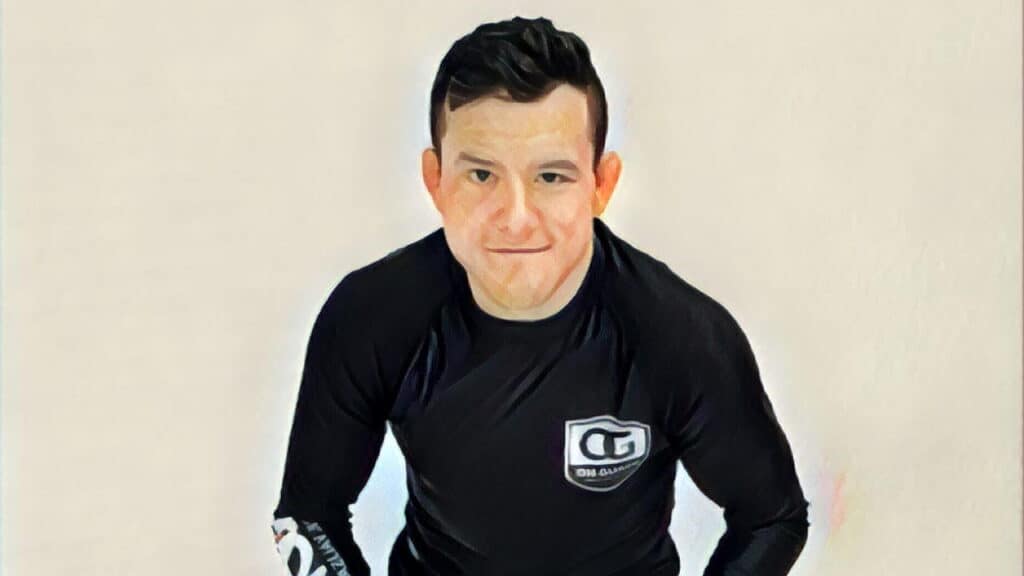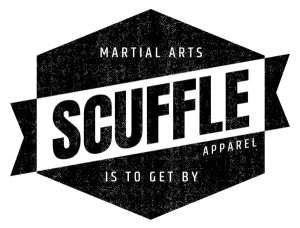
I talk to Matt Kwan, a Canadian black-belt, coach of On Guard BJJ and co-host of BJJ Mental Models. Matt traces his path from chef to full-time instructor, explains why he aligned his academy with Rob Biernacki, and shares the training program he uses to build skilful, self-reliant grapplers. We dive deep into merit-based grading, offensive/defensive cycles, blading for guard passing and the central role of grip-fighting in modern Jiu-Jitsu.
Listen To Matt Kwan
Listen to the Episode:
Topics
Coaching Journey and Philosophy
Matt recounts leaving the kitchen for the mats, absorbing Rob Biernacki’s “alignment” framework and ultimately opening On Guard BJJ. Honest feedback, he says, is priceless: being told his guard was not yet black-belt calibre pushed him to refine it and shaped a culture of continual improvement at his gym.
Merit-Based Grading and Kids’ Tests
Promotion is earned, not gifted. For adults Matt avoids formal tests, judging progress by performance and character. Children receive a structured booklet months before a grading day so they can prepare technique, theory and etiquette with their parents. The aim is learning, not rubber-stamping; failure is avoided by ensuring readiness well in advance.
Tempo – Offensive vs Defensive Cycles
Borrowing chess terminology, Matt explains that you must dictate tempo. If you grip and off-balance, you are in an offensive cycle; if you are merely framing, you have slipped into a defensive cycle. Training should therefore centre on winning the initial grip exchange and forcing the opponent to post their hands, denying them time to blitz.
Blading for Guard Passing
“Blading” means turning your shoulders or hips to shrink surface area and redirect frames. By switching the force angle during headquarters or half-guard passing, you collapse stubborn shields without burning energy, creating openings for chest-to-chest pins or back takes.
The Grip-Fighting Program
Twice a week classes open with mini-games: two-on-one battles from seated guard, headquarters entry drills and blitz scenarios. Removing submissions lets students focus on grip outcomes, inside-leg positioning and immediate off-balances, translating theory into live reactions and reinforcing the offensive cycle.
Simplifying the Game with Age
Now in his thirties, Matt has streamlined his arsenal. Fancy berimbolo chains gave way to reliable funnels such as top half-guard and double-under passes that conserve energy, work against bigger partners and keep him safely in control.
Timestamps
[02:29] – Matt’s backstory
[09:53] – His criteria vs. Rob’s criteria for giving a black belt
[12:26] – About his idea of implementing kids belts test
[16:04] – The goal of the Kids Belt Test
[17:24] – Testing as pass or fail is up to the instructor’s interpretation
[19:49] – Don’t ask a kid to do a belt test unless they’re ready
[21:25] – The carrot and stick approach to encourage and motivate people
[24:02] – Mental models that Matt found applicable
[27:48] – Putting together the defensive and offensive cycle
[30:37] – You cannot hold the De La Riva Guard
[32:15] – The best way to learn De La Riva Guard with offensive and defensive cycles
[34:17] – Try to establish your grip
[36:00] – Head is one of the most underrated grips that you can use
[38:16] – Gordon Ryan’s No Gi Passes
[41:10] – In Jiu-Jitsu, there’s no time to be in the defensive cycle
[42:19] – The best way to put a technique into a live scenario
[44:00] – Have slick guard retention to become offensive
[45:30] – About Matt’s Blading model to redirect frames
[51:05] – Understand the content to the extent that it becomes an obsession
[53:21] – Change the angle of your hips and shoulder to deflect the Knee-Shield
[56:00] – Off-balance your opponent when you’re stuck in a defensive cycle
[57:43] – Ways to interrupt the opponent’s offensive cycle
[01:02:05] – When you got caught in double under the situation
[01:03:45] – Use less energy as possible and make the opponent work more
[01:05:09] – Create high percentage funnels to keep the opponent in the defensive cycle
[01:06:44] – Emphasis of Gi and No-Gi in grip fighting
Topics
Belt Test For Kids
He doesn’t like the idea of a Belt test for kids. He says, “Are you going to fail or pass a kid because it’s a test? And if they fail the test, it can demotivate them. So, it’s a better idea to have this test as more of a handbook or a playbook as opposed to an actual test where you will pass or fail.
He compares it to American Football, where he was the smallest guy in the field who had very little athletic ability. So for the first half of the year, they give him a playbook and learn the plays and practice, and then the second half of the year is the games. He figured out from this that if he looks at this as a playbook and gives it to the kids a few months before their quote test, where they have to perform techniques, then at least they have on paper what they need to know. And if they don’t know it, they can come and ask the coach, or they can study on their own time and also their parents can also get involved in it.
Don’t Spoon Feed The Information
Teach kids how to learn. He doesn’t want them to regurgitate but understand the tricks and techniques. He tells them to explain alignment. He says, “I don’t want them to repeat in my words, what is posture structure base? I want them to be in a position and tell me, Okay, are you in alignment right now? Are you on base? Do you have posture?” In that way, they can take what they’ve learned and plug it into any given situation. In this way, you can know whether or not they’ve understood the principles and if they can apply them to any given situation.”
Theory Part Of The Test
The test that he designed also has a theory for the kids. Like for Grey Belts, you can ask questions: What do you like about Jiu-Jitsu? What don’t you like about Jiu-Jitsu? Why do we shake hands before? Name a time in life when you might have to use the skill. He also wants to make sure that they can do the solo drills needed in Jiu-Jitsu by asking questions like: Can you do a shrimp? Can you do a sit-out? Can you bridge? What’s an under hook? There is value in that for the kids.
Matt Kwan Abolished The Sub-Belts
In the IBJJF model, there are four kids’ belts, and each belt has three sub-belts. Matt abolished the sub-belts in his school. He decided to go on for the grey, yellow, orange, or green belts. He did so because he didn’t want to promote the kids constantly. He wants to make them really want the promotion. The test is not necessarily a pass or fail thing. So the kids can take the test when they are ready.
Mental Models That He Found Applicable In His Journey
The first one is the idea of tempo, which is actually a chess term. Gordon Ryan refers to it as offensive cycles, defensive cycles. He explains it by giving an example:
“Let’s say I’m in the bottom position, and my opponent is on top. So if I were to make a grip, I would off-balance my opponent and force him to post hands on the floor. I’m now in the offensive cycle. This is because I have won the engagement phase using grips, and I’ve made him post on the floor. So I’ve broken his alignment. So for this moment, my opponent is vulnerable. And my opponent is very unlikely to start a passing chain because his alignment is compromised. So he is more concerned about improving his posture. And I have an opportunity now to sweep to enter the legs to go for submissions. So that would be an example of an offensive cycle.”
For Defensive Cycles, he says, “Let’s say my opponent pulls guard on me, and he has a Color Ankle De La Riva Guard situation. He has an open-guard situation. He has a grip on me. So if he has got grips, and he is moving me around. And I’m on top, and I’m feeling a little bit off balance. I’m in a defensive cycle. So for me to get into an offensive cycle, what I need to do is break the grips that immediately break my alignment. As soon as I break the grip, I don’t just start passing right away. I will either try to change the angles, or I will make space. That is where I can change it from a defensive cycle to an offensive cycle.”
In Jiu-Jitsu, There’s No Time To Be In Defensive Cycle
In Jiu-Jitsu, there’s no time to be in the Defensive Cycle. You want to be in the offensive cycle the entire time. It teaches the person on the bottom to always be in an offensive cycle. But it also teaches the person on top to be in an offensive cycle. And the best way to be in a Defensive Cycle is to remove factors like submissions and even guard passing.
Matt Kwan Resources
Quotes
“Not everyone can go to university and become a professor. And not everyone has the skills to earn a real black belt.”
– Matt Kwan
“If you can’t display the requirements, then you shouldn’t get your next belt.”
– Matt Kwan
“The best defense is a good offense.”
– Matt Kwan
“If you don’t know what to do, strip whatever grip your opponents have and try to establish your own.”
– Matt Kwan
“You don’t just get your grips and then stop. It’s a ladder or a sequence that should lead you to the finish.”
– Matt Kwan
Show Notes
Matt Kwan Links
- BJJ Mental Models
- https://www.youtube.com/channel/UC3JMczv6cufhxjeq2D8ANjQ
- https://twitter.com/bjjmentalmodels/
- https://www.instagram.com/bjjmentalmodels

